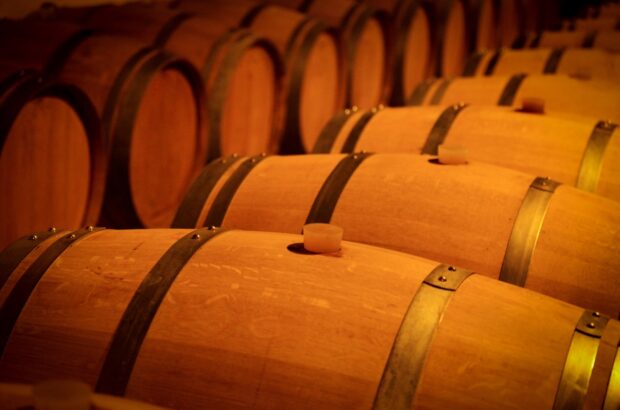We all know what to do with white, red, rosé and sparkling – but what about sweet and fortified wines? These unmatched, flavour-laden classics – because that is what they are – are often overlooked simply because we’re not sure how, when and with what to serve them. We have therefore consulted the experts to provide practical answers and some surprising food pairings. It turns out there are whole worlds to discover beyond the delicious but clichéd Port-Stilton and Sauternes-foie gras combos of yore.
Nobly sweet wines
Heidi Schröck, the Austrian doyenne of nobly sweet Ruster Ausbruch, as well as auslese, beerenauslese (BA) and trockenbeerenauslese (TBA) from Rust in Austria’s Burgenland region – prefers to serve her wines between 12°C-14°C. She loves ‘creative and unexpected’ flavour combinations and signals this clearly on her labels.
‘Ottolenghi recipes lend themselves excellently,’ she says, but also suggests prosciutto with spätlese, aged Gouda with BA, chili-cheese sausages or lamb tagine with Ausbruch. She notes that desserts should not be too sweet – apple tart with rosemary would be perfect.
Aline Baly, who runs Château Coutet in Barsac, Bordeaux, has perfected the art of serving sweet wines with every course. While her ‘absolute favourite’ pairing is lobster, she swears by shellfish starters, roast chicken for main and fresh strawberries for dessert. So don’t restrict yourself to aperitif or dessert for these intense, golden wines.
Baly avoids small dessert wine glasses and goes for white wine glasses instead. She recommends serving at 9°C-10°C, but suggests, ‘a cooler temperature when wines are served with a spicy dish or a sweet dessert. Cooler is also better for very young and much older vintages. Middle-age wines can be served a couple of degrees warmer to allow the warm baking spices to express themselves.’
Leftovers keep well when refrigerated. ‘These wines are resilient,’ Baly says. ‘That you can keep a bottle open for more than a week is a fact unknown to many.’ Schröck agrees: Auslesen last for 10 days, while concentrated Ausbruch can keep for up to three weeks.
Matching Sauternes and Barsac with food
Port
Anthony Symington, brand manager for Symington Family Estates (maker of the Port brands Graham’s, Warre’s, Dow’s and Cockburn’s), says that only vintage Ports need be decanted. He distinguishes between the ‘robust, youthful aromas of red fruits’ of bottle-aged ruby and reserve Ports and the ‘greater complexity, nut and raisin characteristics’ of barrel-aged tawny Ports.
Ruby and reserve ‘should be served at room temperature and are delicious with cheese or dark chocolate’. An open bottle will last three to four weeks. Tawny Ports, on the other hand, should ‘always be served slightly chilled from the fridge and are delicious with creamy desserts such as ice cream, crème brûlée, or a sneaky square of chocolate.’ But he also suggests pairing a 10-year-old tawny with foie gras: ‘The acidity cuts through the richness, and the sweetness complements it perfectly.’
Tawny will last up to six weeks in the fridge. If you are lucky enough to have mature vintage Port, Symington says: ‘Think creamy cheeses rather than Stilton, which can overpower these wonderful old wines. Fresh fruit is also an exceptional pairing.’ Vintage is the only style you have to drink up quickly – it fades within three days.
Cream & sweet Sherry
Tim Holt, Bodegas Barbadillo’s UK area director, lifts the lid on sweet Sherry styles – sweet oloroso and tooth-breakingly sweet Pedro Ximénez, or PX – and even resurrects the much-maligned cream Sherry. He says cream and oloroso should be served chilled and that any tulip-shaped wine glass will do. For PX, he counsels: ‘Pour it on ice cream or try it in a tumbler glass over crushed ice. It works extremely well that way.’
Bourbon vanilla ice cream is particularly delicious with PX. Holt says a classic PX pairing is the Asturian blue cheese Cabrales, but he has fond memories of raw Virginia Bay oysters, too. Hot Mexican habanero and Sichuan dishes are also recommended: ‘The high sugar level has a balsamic effect, so it works for these extremely hot dishes.’ Now you know what to do with that leftover turkey.
Holt stays in Asia for cream Sherry and sweet oloroso, too: ‘They go very well with some Chinese foods, specifically Peking duck and Shanghai cuisine generally.’ While sweet oloroso lasts in the fridge for up to three months, PX does not need chilling, and is so sweet ‘it can last from one year to the next.’
Sherry and chocolate pairing ideas
Madeira
Even Madeira labelled ‘dry’ has some rounding sweetness, so Chris Blandy of Blandy’s Madeira says: ‘We suggest that dry and medium-dry styles (ie, Sercial and Verdelho) be served at 12°C, and medium-rich and rich styles (Bual and Malmsey) be served at 15°C-16°C.’
None of the wines need decanting, and a tulip-shaped Port glass, or slender white wine glass is best. The good news is that ‘Madeira is pretty much indestructible,’ Blandy says, ‘so simply put a stopper back in, stand the bottle upright and store in a cool, dark cupboard.’
With these food combinations, however, it will be hard to resist these utterly complex and even otherworldly wines, especially when you have time to savour slowly. Blandy loves ‘Comté with Sercial, roast chicken with Verdelho, foie gras with Bual’. The sweetest style, Malmsey, is a match made in heaven with Madeiran honey cake or bolo de mel – a moist, dark, spiced molasses cake. But who’s to say that Christmas cake, Lebkuchen or mince pies won’t work almost as well?
Leftover lusciousness: use every drop
At Quinta do Noval in the Douro Valley, cook Maria João turns leftover late bottled vintage or vintage Port into a fruity, sweet sauce for pancakes.
For four people you need: ‘A generous pat of butter, two tablespoons of brown sugar and a full glass of Port. You melt the butter with the sugar in a pan, when it is bubbling you add the Port. Using a wooden spoon, never stop stirring. Let the alcohol evaporate until the sauce thickens, about four minutes.’ She adds that this is ‘not an exact science and needs a little intuition’.
Amontillado is a key ingredient in Bramdean pudding, a speciality passed down through generations at Davy’s London pub The Boot & Flogger in Southwark – but oloroso will also work. For each pudding you need a small ramekin dish. Into this you crumble a digestive biscuit, top it with a few sultanas, pour over 30ml of Sherry followed by a layer of fresh custard. Once set, top with a layer of double cream.







